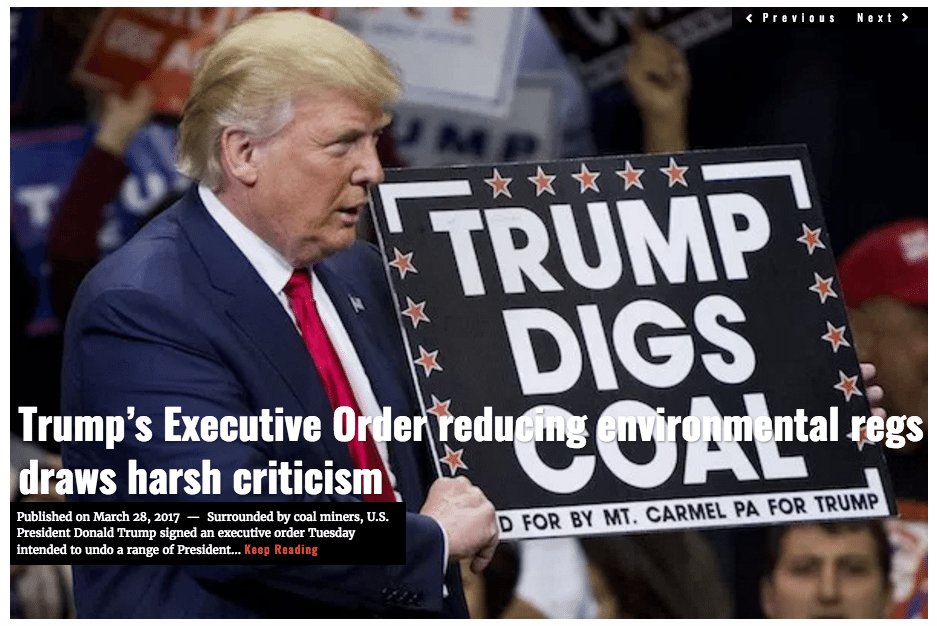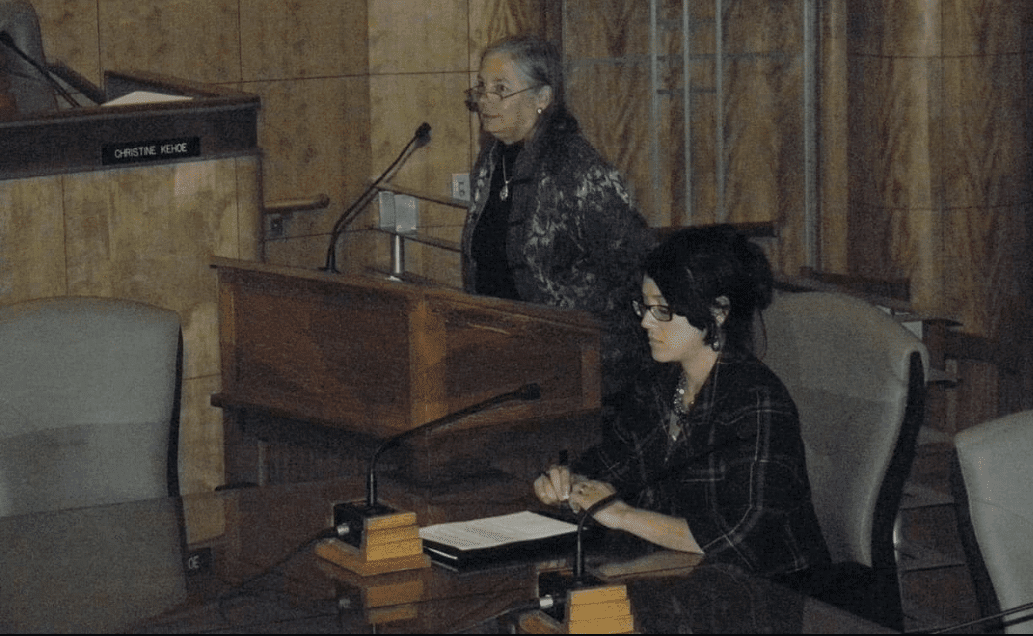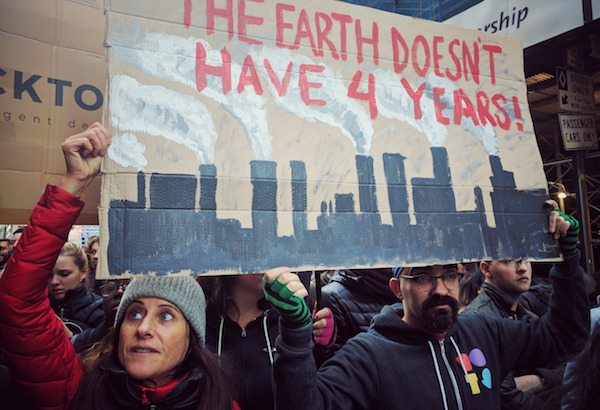The Trump era will, one day, be used as a case study for how it catapulted the environmental industry forward and brought greater attention to climate change.
According to IBISWorld, the environmental consulting industry will grow 18.6 billion despite current efforts to dismantle the system of environmental protections put in place decades ago. The environment will be the defining feature of the Trump presidency. Just as terrorism sparked by the attacks of 9/11 defined the Bush presidency, and the economic crisis of 2008 defined the Obama presidency, I predict that the environment will be a defining feature in the Trump presidency.
Despite or perhaps because of the administration’s threat to dismantle EPA regulations, the Clean Air Act, climate change policies, the Paris agreement and others for the sake of corporate power and interest, there has been an increase in awareness and focus on the issue.
Trump’s own Defense Secretary, James “Mad Dog” Mattis, called climate change a national security issue. Even though government has a hand in establishing environmental and energy regulations and policy, military leaders and big businesses are in the driver’s seat.[1] The answer is simple: security and money.
The Republican agenda of dismantling climate regulations has propelled a movement.[2] To some outside of the environmental industry, it may seem that current politics have constricted the growth of this space. In reality, it has catapulted it. Many industries are reaching out to small firms to learn how to save money on more energy efficient measures and technologies.
According to IBISWorld, the future of environmental consulting and everything in between is promising for the upcoming years.
The current president’s environmental threat has also backfired into a movement among many Americans with different backgrounds. Even competitors within the industry are stepping outside of their box to collaborate with other firms, to work together on projects and create policies, to protect the environment and EPA regulations. A collective movement has also grown towards sustainable cities, capacity/holistic projects and building a resilient “Indian Country” approach. This movement includes projects that focus on “boots on the ground” efforts to boost economic development.

In practice, businesses can positively guide policy towards responsible approaches to the environment. An example of this is the case of the state of Kentucky. Recently, NPR news reported that Kentucky was trying to attract large businesses to move to their state. Unfortunately, they discovered that Kentucky was essentially blacklisted because it lacks progressive energy efficient policies and renewable technology incentives to make it competitive with other states. Even a coal mining state like Kentucky found its citizens, politicians and business leaders willing to create good energy and climate policy. In dire need of an economic boost, Kentucky found itself willing to change policy in order to drive business and economic development.[3]
The Evolution of the Environmental Consulting Industry
It is hard to believe that a little over 47 years ago, the United States passed the Clean Air Act, the Clean Water Act and established the Environmental Protection Agency so that corporations would not release toxic clouds into the air or dump toxic waste into our nation’s waterways. Previously, there were no legal implications or regulatory mechanisms to protect our environment.
Due to regulations and the public’s demand for corporations to become more environmentally conscious, the environmental consulting field was created. Typically, a consultant would ensure that their client maintains an appropriate measure of compliance with environmental regulations. Within this industry, there are many types of environmental consultants. The two primary groups are those who enter the field from the industry side, and those who enter the field from the environmentalist side.[4]

Despite changing political winds throughout the decades, the environmental consulting industry has grown and matured. In the early 1990s, the Clean Air Act was amended imposing harsher regulations as a result of the public’s awareness that greenhouse gases were causing the earth’s temperature to rise, causing a global effect. The media helped create awareness about global warming, its effects on our environment, and our ultimate demise as a human race if things did not change. The American people demanded the U.S. government and corporations to be more environmentally conscious. Science was never questioned.[5] By the early 2000s the U.S. military and our NATO allies were addressing “climate change” as a threat to national security, a game changer for the environmental industry.[6] As global leaders further discussed climate change, environmentalists and industry experts got more popular.

In 2008, only two short years after I had transitioned from the Navy, I found myself under a new president of “HOPE” and an economic recession. Like many other Americans, I felt a sense of uneasiness in the environmental/energy construction and consulting industry. Later in the fall of 2008, the recession bloomed and led to an historic economic collapse felt on a global scale. However, even at the darkest moment there was still opportunity within the eye of a storm.
In the military, we are taught to think creatively. In the “Airedale World” of the Navy we are incentivized to come up with solutions that improve Naval Operations. In the Aviation World of the Navy, I was taught that just because it was always done a certain way doesn’t mean that it must be.
American will, optimism, ingenuity and persistence enabled our country to ride through the storm. Several companies entered the environmental consulting industry space during that time, including my firm, GC Green. The American Recovery and Investment Act gave America the boost it needed for that time. With “use it or lose it” requirements in place many individuals at local municipalities found themselves in charge of thousands if not millions of dollars’ worth of funds, and in some cases an entire energy efficiency program, with little guidance how and where to spend those funds. I personally sat in government and corporate meetings during that time throughout California where cities, school districts and tribal governments were under the wire to spend funds, but were not up to date on renewable energy technology. Additionally, decision makers were not informed and/or did not fully understand the concept that saving energy meant saving money.

When the environmental consulting industry started 40 years ago, it was low margin, highly dependent on regulation, and dominated by established players. It has since evolved, and is changing to one that rewards innovation, creativity, and prioritizes the financial benefit of customers. It is driven by sustainability, and its cousins are climate change and the clean tech revolution. It is dynamic and ready to move ever forward, in spite of the political winds.
Liz Perez, Lima Charlie News
Liz Perez (Aviation Logistics Specialist, U.S. Navy) is a Senior Correspondent for Lima Charlie News. Liz served in the Navy for over eight years with several deployments in the 5th and 6th Fleet, before founding GC Green Incorporated, a veteran-owned “Green Build” general contracting and consulting firm. In 2013, Liz was honored by The White House as a Champion of Change – Veteran Advancing Clean Energy and Climate Security.
Lima Charlie World provides global news, featuring insight & analysis by military veterans, intelligence professionals and foreign policy experts Worldwide.
For up-to-date news, please follow us on twitter at @LimaCharlieNews
Sources
[1] Environmental Consulting in the US: Market Research Report. (n.d.), May 3, 2017.
[2] Meng, K., 2016, November 18.
[3] Ludden, J., 2017, April 17.
[4] EPA History: Earth Day, 2016, October 18.
[5] PRESS, M. L.,1989, October 29.
[6] Mikesell, T. (n.d.) ‘Age of Consequences’, 3/23/17.


![Image Opinion | America’s Upside Down Foreign Policy [Lima Charlie News][Photo: Jonathan Ernst/Reuters]](https://limacharlienews.com/wp-content/uploads/2018/06/Opinion-America’s-Upside-Down-Foreign-Policy-480x384.jpg)
![Image America's obsession with plastic [Lima Charlie News]](https://limacharlienews.com/wp-content/uploads/2018/05/Americas-obsession-with-plastic-480x384.jpg)
![Image President Trump's National Security Strategy - the New Cold War [Image: Lima Charlie News]](https://limacharlienews.com/wp-content/uploads/2017/12/President-Trumps-National-Security-Strategy-the-New-Cold-War-480x384.jpg)
![Africa’s Elections | In Malawi, food, land, corruption dominate [Lima Charlie News]](https://limacharlienews.com/wp-content/uploads/2019/06/Malawi-election-Food-land-corruption-480x384.jpg)
![Image Combat Veterans, Scientists, Gamers work to save the world's dying coral reefs [Lima Charlie News]](https://limacharlienews.com/wp-content/uploads/2018/06/Combat-Veterans-Scientists-Gamers-work-to-save-the-worlds-dying-coral-reefs-480x384.jpg)
![Image Fracking, BREXIT and an oil and gas shale bonanza [Lima Charlie News][Image: Ben Stansall/AFP]](https://limacharlienews.com/wp-content/uploads/2018/04/Fracking-BREXIT-and-an-oil-and-gas-shale-bonanza-480x384.png)
![Image Deep sea mining raises critical issues for the International Seabed Authority [Lima Charlie News]](https://limacharlienews.com/wp-content/uploads/2018/03/Deep-sea-mining-raises-critical-issues-for-the-International-Seabed-Authority-480x384.jpg)
![Image Opinion | America’s Upside Down Foreign Policy [Lima Charlie News][Photo: Jonathan Ernst/Reuters]](https://limacharlienews.com/wp-content/uploads/2018/06/Opinion-America’s-Upside-Down-Foreign-Policy-150x100.jpg)
![Image America's obsession with plastic [Lima Charlie News]](https://limacharlienews.com/wp-content/uploads/2018/05/Americas-obsession-with-plastic-150x100.jpg)